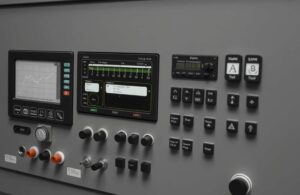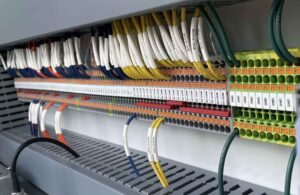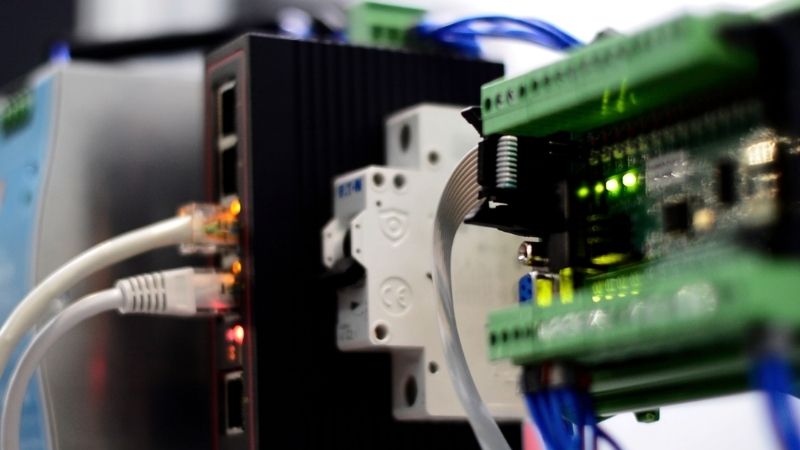Input & Output Analog PLC: Panduan Pengujian & Pemecahan Masalah
Dalam artikel ini, kita akan mempelajari input dan output analog PLC—komponen utama yang memungkinkan PLC (Sistem Kontrol PLC) untuk menangani sinyal dan mengendalikan proses secara akurat. Jika Anda bekerja dengan sistem otomasi, memahami cara kerja sinyal ini dan cara mengujinya sangat penting untuk menjaga efisiensi dan keandalan.
Daftar isi
Apa itu Input dan Output Analog PLC?
Apa sebenarnya input analog dalam sistem PLC?
Input analog dalam PLC adalah sinyal yang menyediakan rentang nilai yang berkesinambungan, tidak seperti sinyal digital yang berupa biner (0 atau 1). Input analog digunakan untuk menerima data dari perangkat eksternal seperti sensor suhu, sensor tekanan, atau meteran aliran. Perangkat ini mengeluarkan sinyal analog (misalnya, 0 hingga 10V, 4-20mA) yang dapat diproses oleh PLC untuk mengendalikan atau memantau proses industri.
Perangkat Input Analog Utama
- Sensor suhu (misalnya, termokopel, RTD)
- Sensor tekanan
- Pengukur aliran
- Sensor level
Sensor ini mengubah parameter fisik (seperti tekanan, suhu, atau aliran) menjadi sinyal listrik yang dapat dibaca, ditafsirkan, dan ditanggapi oleh PLC.
Apa fungsi keluaran analog pada PLC?
Di sisi lain, keluaran analog memungkinkan PLC untuk mengirimkan sinyal variabel kontinu untuk mengontrol perangkat seperti aktuator, katup, dan kecepatan variabel. penggerak (VSD). Misalnya, PLC dapat menggunakan output analog untuk mengontrol motor kecepatan, elemen pemanas, atau perangkat lain yang memerlukan kontrol ketat atas nilai input.
Output analog dapat berupa arus (biasanya 4-20mA) atau tegangan (0-10V). PLC menerjemahkan nilai output yang diinginkan menjadi sinyal analog yang sesuai yang dapat dipahami dan ditanggapi oleh perangkat yang terhubung.
Perangkat Output Analog Utama
- Penggerak kecepatan variabel (VSD)
- Aktuator
- Pemanas
Bagaimana Input Analog PLC Bekerja?
Bagaimana sinyal input analog dihubungkan ke PLC?
Untuk memproses sinyal masukan analog, PLC memerlukan modul masukan analog yang mengubah sinyal tegangan atau arus yang masuk ke dalam bentuk yang dapat diproses oleh CPU PLC.
Misalnya, sinyal arus 4-20mA akan diterima oleh modul input PLC, yang kemudian akan mengubahnya menjadi nilai digital yang dapat digunakan PLC untuk tujuan kontrol.
Bagaimana PLC menafsirkan sinyal analog?
Saat sinyal masukan analog diterima, PLC menggunakan modul konverter (ADC – Analog to Digital Converter) untuk menerjemahkan sinyal analog menjadi nilai digital. Nilai digital ini kemudian digunakan dalam pemrograman PLC untuk membuat keputusan atau melakukan tindakan, seperti mengaktifkan alarm atau menyesuaikan kecepatan motor.
Misalnya, jika sensor suhu mengeluarkan sinyal dari 0 hingga 10V, PLC membaca tegangan tersebut dan, berdasarkan pemrograman yang telah ditetapkan, menafsirkannya untuk mewakili rentang suhu tertentu.
Apa Peran Keluaran Analog dalam Sistem PLC?
Bagaimana keluaran analog PLC mengendalikan perangkat?
Setelah PLC menerima data input, ia dapat menggunakan output analog untuk mengendalikan perangkat. Misalnya, PLC dapat mengambil data dari input analog, memprosesnya, lalu mengirimkan sinyal analog yang sesuai untuk mengendalikan perangkat, seperti katup atau motor. Umpan balik berkelanjutan ini memastikan proses berjalan lancar dan efisien.
Keluaran analog sangat penting dalam aplikasi yang memerlukan kontrol presisi, seperti pengaturan suhu, kontrol kecepatan motor, atau bahkan penyesuaian tekanan dalam sistem pipa.
Bagaimana sinyal keluaran analog dihasilkan?
Sinyal keluaran analog biasanya dihasilkan oleh modul DAC (Digital to Analog Converter) di dalam PLC.
Perangkat lunak PLC mengirimkan nilai digital ke DAC, yang mengubahnya menjadi sinyal kontinu—baik keluaran arus (4-20mA) maupun tegangan (0-10V). Sinyal ini kemudian dikirimkan ke perangkat pengendali.
Bagaimana Menguji Sinyal Analog PLC Secara Efektif?
Apa cara terbaik untuk menguji sinyal masukan dan keluaran analog PLC?
Pengujian sinyal analog PLC sangat penting untuk memverifikasi bahwa sistem Anda berfungsi dengan baik. Berikut cara melakukannya:
Menguji Input Analog:
- Gunakan multimeter untuk mengukur sinyal input dari sensor ke terminal input PLC. Pastikan tegangan atau arus berada dalam kisaran yang diharapkan (misalnya, 4-20mA atau 0-10V).
- Simulasikan sinyal input menggunakan generator sinyal atau simulator. Ini membantu memastikan PLC merespons dengan benar terhadap nilai yang berbeda.
Menguji Keluaran Analog:
- Gunakan pengukur tegangan atau arus untuk mengukur keluaran dari terminal keluaran analog PLC.
- Anda juga dapat menggunakan penguji loop untuk mensimulasikan keluaran dan memverifikasi koneksi.
Pengujian sinyal analog memastikan sistem PLC membaca masukan secara akurat dan menghasilkan keluaran yang tepat, yang sangat penting untuk menjaga kelancaran operasi dalam proses industri.
Bagaimana saya mengetahui apakah PLC berfungsi dengan benar?
Untuk memverifikasi bahwa PLC memproses sinyal secara akurat, Anda dapat memeriksa program PLC untuk penskalaan dan kalibrasi yang tepat. Misalnya, pastikan bahwa rentang sinyal input (0-10V atau 4-20mA) sesuai dengan spesifikasi sensor.
Selain itu, Anda dapat menguji respons PLC dengan menyesuaikan masukan analog secara manual dan mengonfirmasi bahwa keluaran analog yang sesuai berubah seperti yang diharapkan.
Masalah Umum dengan I/O Analog PLC dan Cara Mengatasinya
Mengapa masukan analog PLC saya tidak terbaca dengan benar?
Salah satu masalah umum dengan input analog adalah gangguan sinyal, yang dapat mendistorsi sinyal input dan menyebabkan pembacaan yang tidak akurat. Hal ini dapat disebabkan oleh gangguan listrik, kabel yang tidak tepat, atau sensor yang rusak. Untuk mengatasi masalah ini:
- Lindungi kabel untuk mencegah gangguan.
- Pastikan pembumian sensor dan PLC benar.
- Ganti sensor atau kabel yang rusak.
Bagaimana cara memecahkan masalah keluaran analog?
Jika output analog tidak berfungsi seperti yang diharapkan, masalahnya mungkin ada pada modul DAC, kabel, atau perangkat yang terhubung. Periksa hal berikut:
- Pastikan kartu keluaran terpasang dengan benar.
- Verifikasi koneksi antara PLC dan aktuator atau perangkat.
- Periksa apakah ada kabel yang rusak atau sambungan yang longgar.
Pertanyaan yang Sering Diajukan
Apa perbedaan antara masukan analog dan keluaran analog pada PLC?
Masukan analog digunakan untuk menerima sinyal kontinu dari sensor, sedangkan keluaran analog digunakan untuk mengirim sinyal kontinu ke perangkat kontrol seperti aktuator atau motor.
Bagaimana saya dapat menguji sinyal analog PLC tanpa multimeter?
Anda dapat menggunakan simulator sinyal untuk mensimulasikan sinyal analog dan memeriksa respons PLC untuk memverifikasi apakah berfungsi dengan baik.
Mengapa tegangan pada masukan analog saya tidak stabil?
Hal ini dapat disebabkan oleh gangguan dari peralatan di sekitar, sambungan yang longgar, atau sensor yang tidak berfungsi dengan baik. Pastikan semua sambungan aman dan coba lindungi kabelnya.
Bagaimana saya dapat mensimulasikan sinyal analog untuk pengujian?
Anda dapat menggunakan generator sinyal untuk mensimulasikan berbagai level input analog (misalnya, 0-10V atau 4-20mA) dan memverifikasi bagaimana PLC memproses sinyal-sinyal ini.
Dukung proyek Anda dengan PLC Omron, Mitsubishi, Schneider baru dan asli – tersedia sekarang!
Kesimpulan
- Masukan analog PLC memungkinkan sistem menerima sinyal kontinu dari sensor, sementara keluaran analog mengirimkan sinyal kontrol kontinu ke perangkat.
- Pengujian sinyal analog PLC secara berkala memastikan pembacaan dan respons akurat dari sistem.
- Pemecahan masalah I/O analog melibatkan pemeriksaan gangguan, kabel yang rusak, dan memastikan konfigurasi program PLC yang benar.
- Pengkabelan, pelindungan, dan kalibrasi yang tepat sangat penting untuk operasi analog yang andal.
Dengan memahami dan memelihara sistem analog PLC, Anda dapat mengoptimalkan proses otomasi, mengurangi kesalahan, dan meningkatkan keandalan sistem secara keseluruhan.
Sedang mencari PLC baru dan asli untuk proyek Anda? Di Kwoco, kami menyediakan PLC terbaru dari merek-merek ternama seperti Omron, Mitsubishi, Dan Bahasa Inggris SchneiderBerbelanja dengan percaya diri—pengiriman cepat, kualitas terjamin! Beli Sekarang
Hubungi kami
Cukup isi nama, alamat email, dan deskripsi singkat pertanyaan Anda dalam formulir ini. Kami akan menghubungi Anda dalam waktu 24 jam.
Kategori Produk
Produk Penjualan Panas
Anda Mungkin Juga Menemukan Topik Ini Menarik

Bagaimana cara mengatasi masalah pengunduhan program PLC Siemens?
Cara Mengatasi Masalah Pengunduhan Program PLC Siemens? Pernahkah Anda memiliki program PLC Siemens yang tidak dapat diunduh?

Apa itu Sistem Otomasi?
Sistem otomasi telah menjadi tulang punggung industri modern, yang mengubah cara kita memproduksi barang dan jasa. Artikel ini membahas secara mendalam tentang apa itu sistem otomasi, berbagai jenis otomasi, dan mengapa sistem otomasi sangat penting di dunia saat ini. Di akhir artikel, Anda akan memahami bagaimana otomasi memengaruhi industri dan kehidupan sehari-hari, sehingga buku ini wajib dibaca oleh siapa pun yang ingin tahu tentang masa depan teknologi.

Apa itu PLC Ladder Logic dan Bagaimana Cara Kerjanya?
Programmable Logic Controller (PLC) merupakan tulang punggung otomasi industri, dan ladder logic merupakan bahasa pemrograman paling populer yang digunakan untuk menginstruksikan PLC ini. Artikel ini membahas dasar-dasar ladder logic, mengungkap cara kerjanya, dan mengapa penting bagi siapa pun yang tertarik dengan pemrograman PLC untuk memahaminya. Baik Anda seorang insinyur berpengalaman atau baru mengenal otomasi, panduan ini akan meningkatkan pengetahuan dan keterampilan Anda.






